Part 8
1911 RURAL SCHOOL
In October of 1911, my Grandmother Phoebe Phillips Stamp received a card from her friend, Miss Elsa Goersz of Yutan, and a teacher in Dist. #8 which was located south of Yutan. On the card the message states she has no time to be idle as she has 35 enrolled in the school. In the wintertime she would have from 5 to 11 more attending. The above picture was on the card which was mailed with a one-cent stamp. In looking up the records, I find the following names on the schools enrollment:
Ethel Ohm, Hulda Ohm, Ella Trost, Laura Heldt, Rosy Heldt, Herbert Heldt, Annie Eggers, Lizzie Eggers, Willie Eggers, Otto Heldt, Helen Heldt, John Eggers, Willie Heldt, Mabel Backens, Leona Backens, Rose Backens, Clara Wicht, Otto Mumm, Edgar Mumm, Ruth Arp, Annie Arp, Elsie Frahm, Willie Frahm, Laura Schulz, Oscar Schulz, Frances Draper, Harvey Draper, Marie Arp, John Arp, Frederick Arp, Harry Jurgensen, Dorothy Jacobs, Arthur Jacobs, Willie Jacobs, Bertha Wagemann, Lizzie Wagemann, Harry Wagemann, Lillie Beutler, Walter Beutler, Raymond Beutler, Evan Sake. Submitted by Mrs. Roma (Ken) Smith
SCHOOL BOARD ASSOCIATION
On September 18, 1973, the Rural School Board members of Saunders County Class One school districts met and selected an advisory board formed from two representatives each from the four corner sections of the county, divided by Highways 109, 30-A, and 77, which dissect the county.
The eight members representing the four districts consisted of Joe Ondracek, Fremont, District 119; Maynard Traeder, Fremont, District 11; Robert Mason, Ashland, District 5; Mrs. Luella Hanson, Ithaca, District 50; Mrs. Mary Ann Osmera, Weston, District 74; Kenneth Schoen, Weston, District 44; Mrs. Olga Virka, Cedar Bluffs, District 91; and Don Virgl, Weston, District 83, temporary chairman. Edgar Knox was County Superintendent.
page 23
The Saunders County Rural School Board Association was formed to promote better Class One school districts and to provide better and more uniform education in the rural grade schools, so as to better adapt the pupils to high schools they will attend.
The organization will also aid the Class One school boards in acquainting them with the various county, state and federal forms.
The present Advisory Board members include Francis Divis, Wahoo; Olga Virka, Cedar Bluffs; Tom Konecky, Wahoo; Don Proett, Wahoo; Leonard Chmelka, Malmo; Janet Kauffman, Fremont; Stan Keiser, Ashland and John Bergwell, Ithaca.
This is the only such organization in the state of Nebraska - perhaps even - in the United States. Submitted by Olga Virka
HIGHWAY DEVELOPMENT
The current era of highway development in Nebraska began with the acceptance by the state in 1917 of the terms of the Federal-aid Road Act of 1916.
The system of State Highways so designated and established on April 19, 1919, consisted of a network of 79 district routes having an aggregate length of approximately 4,500 miles.
Originally, U.S. 77 was known as the Cornhusker Highway across Nebraska, and was marked by painted signs on telephone poles. These signs had a white background with red bands and red letters. Early road maps of the day advised "follow the painted poles to your destination."
The first numbered signing also began in 1919, using the designated statutory route numbers 10 to 88. These numbers were painted on a board sign black on white and erected along the route. So it was that U.S. 77 in the Swedeburg area was first marked as Nebraska Highway 15.
Nebraska adopted the AASHO uniform markers in 1926 and, as a result, Cornhusker Highway became U.S. 77.
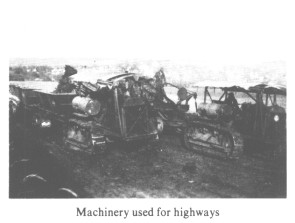 |
| Machinery used for highways |
When Cornhusker Highway was designated a part of the State System in Saunders County, it followed existing earth roads that had been built by the county and townships. The first major grading project on this highway using Federal assistance began May 26, 1919, and was completed across the county by May 1, 1920, at a cost of approximately $75,000.
The first gravel surfacing for the road was also completed in June, 1920, from Swedeburg via Wahoo to Colon. The remaining sections were graveled during the years 1924-26.
Bituminous surfacing was completed from the Lancaster County line to Wahoo, and from Mead north to the Platte River in 1938.
From the Lancaster County line to about one mile north of Swedeburg it was paved with portland cement concrete in 1947. In 1948, the concrete paving to Wahoo was completed, followed in 1954 with paving of the highway from Mead north to the Dodge County line.
The Highway 77 original route was through Swedeburg. In 1930 Highway was relocated one mile west of Swedeburg. Then in 1937 - relocation to the east side of Swedeburg. This information came from the Department of Roads, Kenneth Schneider, Planning Division.
THE IRON HORSE COMES
The first railroad in Saunders County was laid in the summer of 1870 from Plattsmouth through Ashland to Lincoln by the Burlington and Missouri River Railroad Company. Even though it covered only 2 or 3 miles at the extreme southeastern part of the county it was a great benefit to the pioneers of that area.
In 1876 the Omaha and Republican Valley Railroad extended its line from Valley to Wahoo, setting up two new townsites along the way, Clear Creek (later re-named Yutan), and Alvin (later re-named Mead). In 1877 this line was extended through Weston and Touhy to Valparaiso. It was the first railroad to cross the county from northeast to southwest. This line became fully operational from Valley to Lincoln and Stromsburg in 1880, providing excellent passenger and freight service to this area.
The Fremont, Elkhorn and Missouri Valley Railroad started laying rails from Fremont west to near Ames in 1886. The railroad crossed the Platte River and linked the towns of Cedar Bluffs, Colon, Wahoo, Swedeburg, and Ceresco with Lincoln in a north-south direction. In 1889 a line from Platte River Junction, just north of Cedar Bluffs, was laid west through Morse Bluff and on to Superior and Hastings.
Wahoo, the County seat of Saunders County, was the transportation center of the three railway systems. The O & R.V. (later absorbed into the Union Pacific) had a depot in the extreme eastern part of town; the F., E, & M.V. (later a part of the Chicago and Northwestern) had a depot in the central part of Wahoo; and the B. & Mo. River Railroad (later acquired by the Chicago, Burlington & Quincy Railroad) had a depot in the southwestern part of the city. All of this transportation gave the people of Wahoo the opportunity to ride trains in six different directions.
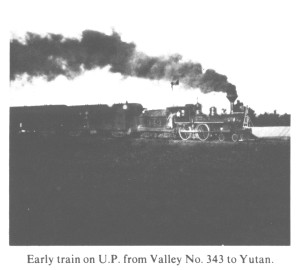 |
| Early train on U.P. from Valley No. 343 to Yutan. |
All three of these Railroads converged on the south edge of Wahoo in a unique engineering triangle crossing, each forming a side of the triangle, and each railroad crossed the other two lines. Strict rules and regulations were observed by the three railroads concerning this crossing in order to prevent accidents, and any infraction of the rules carried a heavy penalty in fines.
The Burlington Line continued to expand by laying new track from Fremont to Ashland in 1905-1906. This track followed the eastern boundary of the county along the Platte River and included Woodcliff, Leshara, Yutan, and Wann, and gave excellent train service to these communities.
During this 36-year period, from 1870 to 1906, three railroad lines laying track westward from Omaha, and north and south from Sioux City, Iowa, to Lincoln, Nebraska, furnished a rail connection from every town in Saunders County.
In 1917 the Burlington built a connector line from Chalco (just west of Omaha) to a point one mile south of Yutan called the "Chalco Cutoff". It was designed to shorten the route from Omaha to Sioux City by bypassing Ashland. However it did not get very much use because of the steep grade from the river bottom to the bluff, and was abandoned after a few years.
During their heydey the Railroads provided transportation, goods, services, and jobs. The tracks had to be maintained by crews of men in nearly every town. Every Depot had from one to four employees. A place like Valparaiso supported 3 Section Crews, a resident bridge gang, Round-House forces, coal-and-water tenders, plus Depot clerks. Ashland, on the Burlington, had a considerable number of similar jobs which contributed to the local economy and to the prosperity of the community.
World War II was a busy time for all railroads, and Saunders County was no exception. The Nebraska Ordnance Plant near Mead was a huge sprawling project covering 27 sections of land (17,000 acres) where the largest bombs used in the War were loaded. The Plant was served at the north entrance by the Union Pacific, and at the south entrance by the Burlington out of Ashland. Some of the bombs weighed eleven (11) tons each and were shipped one to a boxcar, consigned to either coast for overseas destinations. Many miles of track were laid inside the Plant by crews supervised by former Railroad employees.
At this time people were asked to conserve for the war effort, and railroads discontinued many branch line trains, and in some cases even the branch lines. The steel could be used in the war effort, and the oil and gas also could help win the war. The Union Pacific discontinued its motor train, and the C, B, & Q abandoned its track from Prague to Schuyler.
After the war, diesel powered units were becoming popular and the steam locomotives were starting to phase out. The diesel units were flexible and required less maintenance. By 1952 over half of the power units on the railroads were diesel electric. With the passing of the steam age went the coal chutes, water supply tanks, water softener facilities, and the use of coal as fuel, as well as many jobs, some of which were absorbed in other departments.
In 1962 the Northwestern abandoned its line through Morse Bluff, and in 1981 the entire line from Fremont to Lincoln was abandoned and the rails removed. These lines were built of light weight rail (72 lbs.) and are not capable of handling the heavy cars used by today's freight carriers.
The Ashland to Prague line of the Burlington has not been used for the last couple of years and since it is also of light rail it appears that its days are numbered. So three towns (Ithaca, Morse Bluff and Prague) will be without railroad connections. All of their freight will have to be trucked in and out, as most of it, except grain, has been for some time.
The Union Pacific line is still intact and will probably remain so. It has been continually upgraded and has a good, well maintained roadbed, and is comparable to any main line. It enjoys a good density of traffic with some 100 car trains moving to the Gulf and West Coast ports.
Likewise the Burlington Northern has kept its Fremont-to-Ashland line upgraded, and has 100 car unit coal trains as well as grain and other commodities moving to their destinations.
It appears that Wahoo will lose 2 of its 3 railroads as well as its unique Iron Triangle Railroad Crossing, and Yutan in Union Precinct will have the distinction (at least for the time being) of having the most railroads (2) in the County.
In retrospect, the coming of the Iron Horse to Saunders County was one of the greatest contributions to the development and prosperity of the area than any single historical event. Having three ribbons of steel traversing our county made us thrice blessed, and was nothing short of a miracle especially when we consider that some counties in Nebraska have never smelled the smoke of the Iron Horse nor have felt the sting of hot cinders belching from its stack. Submitted by Roy A. Johnston
page 24
RAILROADS
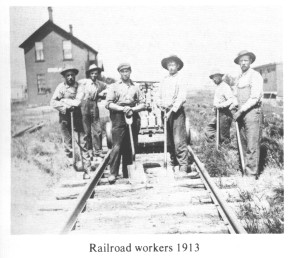 |
| Railroad workers 1913 |
The railroads played a big part in the growth of the Co. By 1870, every acre of government land had been taken up by the settlers who continued to arrive as long as they could find cheap land. This influx of population was checked in 1871; not because all the land in the Co. was settled upon, but because half of it was claimed by two powerful railroad corporations, who were in dispute about their respective titles to the same; neither of which could, under the circumstances, sell. This was a great detriment to the Co., keeping out immigration and preventing improvements. Another drawback in the early days was the lack of railroad facilities through the Co., to assist in the building of towns and manufacturing establishments. The people failed to secure the Omaha and Southwestern and the Ashland and Columbus lines, and this was a grave mistake.
In 1875, two propositions were made; to build a narrow gauge road from Omaha, westerly through Wahoo to Polk Co.; the other to come from the Atchison and Nebraska R.R. Co. for a broad gauge extension of their line from Lincoln to Fremont. The people voted for the Atchison and Nebr. offer.
By 1886, the Chicago, Northwestern R.R. Co. stretched through the county north-to-south, from Fremont, through Cedar Bluffs, Wahoo, continuing to Lincoln. Lumber and passengers were carried into the county; while grain and livestock were hauled out. People traveling to Fremont, Wahoo or farther went by train. Extra cars were added during the State Fair times. As the auto came into use, passenger business dwindled. Today the tracks that crossed the county for almost a hundred years are being removed, and the lonely sound of trains has become a thing of the past in the Cedar Bluffs area.
Today the Co. is crossed (east to west) by a branch line of the Union Pacific R.R.
Mrs. R.N.H. Kelly was the first lady to ride over the Omaha and Republican Valley R.R. when it was completed through Saunders Co. The road is now known as the Union Pacific R.R.'s branch line that comes from Valley, Ne. passing through Yutan, Mead, Wahoo, (south) Touhy, Valparaiso and (west) Weston.
WEATHER
The weather of Saunders Co. can give us much to talk about. It can be beautiful and serene, or violent and severe. As has been noted about Nebr. weather, "If you don't like it - wait 15 minutes and it will change."
The mean annual rainfall is 30.21 inches, 75-80% of which falls from April to Sept. Average annual snowfall is 20 inches. The mean temperature is 50.9 degrees and the growing season is approximately 161 days. On the average, nearly 25% more moisture fell in this area in 1982.
The coldest recorded temperatures was on Feb. 15, 1866 - 32 degrees below zero, (1936 - 31 degrees below zero). We cannot attempt to record all the county's unusual weather of the years in this account but will record some of the most spectacular.
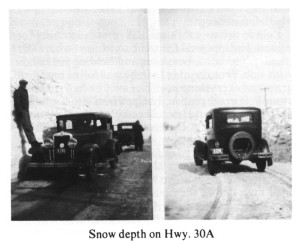 |
| Snow depth on Hwy. 30A |
BLIZZARDS
The years of 1888, 1936, 1949, 1971 and 1975 will be well remembered for the worst blizzards. The storms were in full force due to the wind speed and blinding snow.
The month of January statistics for the years were:
January 10, 1975 - Temperature 4 degrees - Wind Speed 60; January 4, 1971 - Temperature 4 degrees - Wind Speed 50; January 27, 1949 - Temperature 8 degrees - Wind Speed 50; January 12, 1888 - Temperature minus 6 degrees - Wind Speed 42.
Many old-timers of the communities still recall the blizzard of 1936 as they started digging out from the 14 inches of snow left January 10, 1975. The oldtimers remembered that the wind blew the better part of a week, snow drifts were 12 feet deep or deeper, and were as high as building tops. It took days to open the roads. There was also a bad blizzard on Armistice Day of 1941.
The storms of January 2, and 27-28 of 1949 were ones of several that struck Nebraska that month and the previous month making it devastating. It lasted two days on January 2 and 3, 1949. The storm had veered sharply northward out of Kansas. In some parts of Nebraska one could see 50 foot drifts due to large amounts of snow along with the high wind speeds. Everything came to a standstill during all of these blizzards. Livestock really suffered in the 1949 storm.
Many deaths occurred in the state in the 1888 blizzard; called the school teacher's blizzard, but due to lack of accurate records, they are only estimates.
People were not prepared for the blizzard of 1888. It started out to be a bright and warm day and gave little hint of what was to happen. No advance weather warning as one has by television today. The suddenness of which the storm struck left the community paralyzed.
Miss Alma Carlson, age 17, a school teacher near Colon, Ne. kept her school children safe until rescue arrived. In her effort to secure help she was trapped in a haystack for 9 hours. She suffered partial freezing of her feet and hands.
Many residents of Saunders Co. are members of the Blizzard Club of 1888, because some one or more of their ancestors lived thru the ordeal.
Cold weather was recorded in 1974 with a record of 31 below zero in the county. Oldtimers recall many winters with 20 below. But it was a cold one on January 12, 1974. Taken from the Wahoo paper is January statistics listed below:
| Jan. | High | Low | Precipitation |
| 1 | 7 | -20 | 0 |
| 2 | 10 | -4 | 2 in. of snow |
| 3 | 15 | -11 | 0 |
| 4 | 14 | -15 | 0 |
| 5 | 15 | -10 | 0 |
| 6 | 10 | -9 | 4 in. snow |
| 7 | 11 | -19 | 0 |
| 8 | 10 | -9 | 0 |
| 9 | 9 | -20 | 2 in.snow |
| 10 | 12 | -9 | 4 in. snow |
| 11 | 11 | -10 | 1 in. snow |
| 12 | 9 | -31 | 0 |
| 13 | 22 | 2 | 0 |
The storm of December 27, 1982 left the county paralyzed for several days due to the ice left after the blizzard. That Tuesday night of rain, sleet, snow and howling wind left many parts of the county without Electricity. Some people were without electricity for 48 hours due to the icestorm. The combination of ice, snow and wind made it difficult to repair many downed power lines. The streets and roads were a glaze and very treacherous to vehicles and people of the county. The trees were very beautiful when the sun's rays made them glisten but the ice remained for over a week and caused much tree damage. Worst storm, of its kind, ever recorded for utility companies.
At 3:00 pm on the evening of April 13, 1983, a freakish blizzard blew up out of the northwest. By morning the next day, roads were blocked, schools were closed and all activity was at a standstill. The wind gusted up to 37 miles an hour and wind chill temperatures were at minus zero. Valparaiso recorded 6" of snow.
A new snow record was set in April of 1983 with 10.3" being recorded at Omaha for the month, as of April 14.
This is the anniversary of a very bad blizzard on Easter Sunday, April 14, 1893. It is recorded in Chester Precinct papers that there was a "terrible snowstorm on April 12-15, 1873. Some settlers froze to death."
Such is the weather of Saunders County!
THE BLACK BLIZZARD, MAY 22, 1933
I will always remember May 22, 1933. During the dry depression days, so many strange things happened. It was not unusual for terrible dust storms to arise from any strong wind. We realized our good black soil was blowing to the north. Soil was piled up along fence lines like drifts of snow.
On this particular day, which seemed like any other windy day, it started to get dark at noon. Something different was happening. We hoped it was a sign that we would get some long-looked for rain; but no rain came. Many evenings we sat on the back porch, watching sheet lightning flashing across the western sky but no rain came. On May 22, even the animals knew, and wanted shelter from the dust which the wind had put into motion. Upon going out in the yard, I saw each barb of the wire fences sparkling like lights on a Christmas tree.
The ends of the cows' horns were bright as though a fire was burning within. People were not able to drive against the south winds. Dust drove their cars into our yard. It looked like a parking place. Some folks stayed until morning.
Our house was a large stucco house, well-built; but I could not keep the fine dust from entering. It was everywhere; you inhaled it, you ate it. It was like something evil creeping upon us.
Then came the dawn of another day. Was it to be another yesterday? We looked. The sun was shining upon a red world. The ground, buildings, trees were red. Everywhere there was a beautiful red soil which had settled during the night.
Where did it come from? We think it had to be from Oklahoma. Our top soil blew north and we got red soil from the south. By Ellen Davis
TORNADOES AND CYCLONES
Tornadoes and cyclones have ripped across the area all too often. An early record tells: A tornado struck the Franklin Cook farm 4 1/2 miles so. of Wahoo, causing damages estimated between $1200 to $1500.
Easter Sunday (March 23, 1913) could probably go down as the day of the greatest weather tragedy in the county when a funnel shaped cloud appeared in the southwest, whipping its way toward Yutan.
page 25
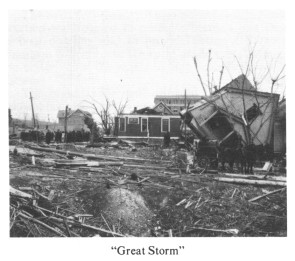 |
| "Great Storm" |
It came with a roar, "much like a lumber wagon rolling over very rough road." Most of the people didn't know what was happening until it was over. Quiet settled for a few minutes after the storm struck. Then people rushed out of homes that were collapsed. Fire broke out in the ruins and lack of water prevented effective fire-fighting. The pumping station had been severely damaged.
A second storm passed over, but it did not cause too much more damage.
Four churches were demolished and many homes. Recovery was greatly helped by the prompt and effective functioning of a Relief Committee headed by R.H. Park and William Miller and by aid of the Red Cross.
TORNADO - MARCH 14, 1919,
AS TOLD BY PASTOR F.W.
DABERKOW IN CEDAR BLUFFS
My son, Christian, was in the school sweeping when he saw cornstalks flying past the windows; going to the window he could see pieces of wood flying about. As he stepped back, the stove pipe hit him and he saw the roof was gone. Dazed, he tried to find shelter between the desks before losing consciousness.
In the house, I was at my desk, Mother in the kitchen, and Helen in the dining room. Suddenly it became so dark that I could not see my work. Entering the kitchen, I looked out of the west window. As I looked the smokehouse blew away, turning over in the air. Helen called that the church was gone. I thought that was impossible, but one glance convinced me that the place where the church had stood was empty.
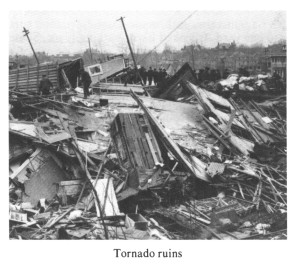 |
| Tornado ruins |
At that moment I realized it must be a tornado and I thought of Christian outside. I ran to the kitchen door, but it was closed as though it were nailed. No matter how hard I tried the air pressure would not allow it to open, or was it a Higher Hand? I stood every moment expecting the house to crash. "O God. God help us!" was all I could say in the terror of the moment.
A noticeable tremor went through the house, then it became quiet. I tried the kitchen door again and this time it opened. What a mess of ruins lay before me! The porch was strewn with bricks from the chimneys, everything was thrown topsy-turvy, not a path was open to the school, or rather, to the place where it had been.
I made my way through the ruins, searching for my son. He appeared from the southwest where our granary had been, bent over and holding his hands to his side. From head to foot, he was full of mud and straw and everything possible, as if he had rolled in a mudhole in the pigpen. I helped him into the house where Mother and Helen began cleaning him up. It took an hour to cut the clothing from him and get him into bed.
People began arriving, and I sent for Dr. Stuart. Before the doctor came, I looked the place over, and it was terrible. Church, school, barns, everything piled high before the house. The church had been turned over and crushed. A little farther south stood the Ford without top or windshield, fenders bent up, but standing on the wheels. The cows stood a ways off, one with the stanchion still around her neck. The school was totally demolished, the floor lay about two feet off the foundation but cleaned off except for a 4-inch piece of one desk leg. The desks had been fastened to the floor with 8 to 12 screws in each.
As the storm had destroyed the school it had passed the church, but no, the church had to go, too. The tornado turned and took the church from the east, lifted it from the foundation and threw it westward, lifted it up again and upset it and threw it just south of the house, crushing and tearing it apart. The Bible was undamaged, the agenda slightly harmed, the crucifix was whole, and candelabra bent a little.
How graciously God had protected us in the storm! One could tell much more, but the particulars are not all to be told, many of them are forgotten. Submitted by Mrs. John (Esther Hoffman) Royuk
HAIL STORMS
Hail storms strike quite often, generally in the spring. Many a farmer has been ruined by a sudden hail storm which strips his crops and even kills livestock. "Hail Strips" sometimes form and a certain area can be hailed out several years in a row. Everyone watches those rolling greenish clouds, quite often from the northwest, that bring such devastation. They do strike somewhere almost every year. One farmer was heard to lament after a cruel storm. "I've taken hail insurance for 19 years and didn't need it so I dropped it this year. Now my crop is ruined."
STORM
In August, 1929, an extremely damaging hailstorm, with much rain and winds destroyed our corn crop. The water flooded our pasture as the creek overflowed. After water drained away, flotsam was piled so high along the creek's banks, it reached under my mother's armpits.
The hail was insulated by the trash so well, that one week later, I prepared some ice cream mix, poured it into a five pound tin syrup pail. I pressed this into the hail and twirled it back and forth and froze ice cream. Ella (Beranek) Travnicek
FLOODS
The low-lying areas around the River are watched fearfully each year, when the ice breaks up in the Platte. Flooding can be very severe. The river bridge used to "go out" almost every year. Flooding by stream and creeks and severe thundershowers do a great deal of damage to crops and soil almost every year.
The most recent flood was 1982 hitting very hard around the Ashland, Clear Creek area.
DROUGHTS
Droughts have plagued this area, too. The pioneers tell of the terrible dry years of the 1890's. They could raise very little but the soil did not blow so bad, because the protective cover of much of the remaining prairie grass.
The drought of the 30's was one of the most damaging things to happen to our county. The rains stopped, streams dried up and the river dwindled down to a trickle. One year the corn didn't even sprout. Food became scarce and prices rose. Everyone was hard put to survive. Wind damage caused great dust storms because the protective cover of vegetation was gone. Poor farming practices due to over-cultivation, "to feed the world", during WWI had caused farmers to over-till the land. Much of the farms were sowed to wheat. Trees died and there was nothing to stop the wind.
In 1934, great curtains of dust were carried clear across the continent. Geologists believe that the lower Mississippi Valley was made more fertile by the soil from dust storms here.
The rains came again and better farming practices were used. Trees were planted again. The New Deal can be credited with putting into force many good conservation plans. Shelter belts were started.
The years between 1950 and 1954 saw another drought period but it was not quite as bad as the 30's because better conservation had been practiced.
BLOODMOBILE
The first bloodmobile was hosted in Wahoo in 1949 with Muzzy Miller as chairman. Since then hundreds upon hundreds of volunteers in the area have worked together on bloodmobiles throughout the years.
Currently, Wahoo holds three two-day visits per year in addition to the annual visits to Prague, Yutan, Valparaiso and Cedar Bluffs. Donors come from all of the surrounding area. Family tradition of donating blood plays an important role in supporting the blood program. The donors are to be congratulated for the gift they give as the Saunders County Chapter received the Gold Frame Award at the annual blood conference. The chapter attained 142% of the annual quota.
Mrs. Jerome (Joyce) Breunig is the present Blood Services Chairman.
RURAL SCHOOLS
The number of rural schools is slowly diminishing. Saunders County has 31 rural schools out of the 330 rural schools left in the state of Nebraska. They are District Numbers: 3, 5, 11, 14, 18, 19, 20, 23, 24, 27, 34, 36, 44, 50, 51, 54, 60, 70, 74, 75, 83, 87, 91, 103, 105, 110, 111, 115, 117, 118, and 119. In 1966 there were one-teacher schools numbering 1,413 in Nebraska.
The rural schools bring memories of a flag pole, merry-go-round and swings, wooden floors, a bell rung by the teacher to declare the end of a recess, the lunch pail, the country school programs and picnics.
Rural schools have changed over the years from 40 to 50 students to 20-25 students to now 3 or 10 students per school. In Saunders County we do have several 2-3 rural teacher schools left.
The schools will be well-remembered as the roots of our county. Truly a tradition carried down thru the generations.
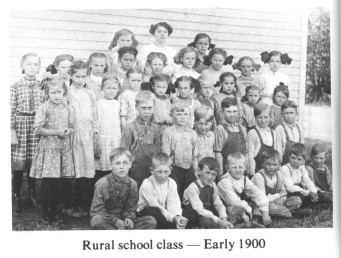 |
| Rural school class - Early 1900 |
Page 26
| 






